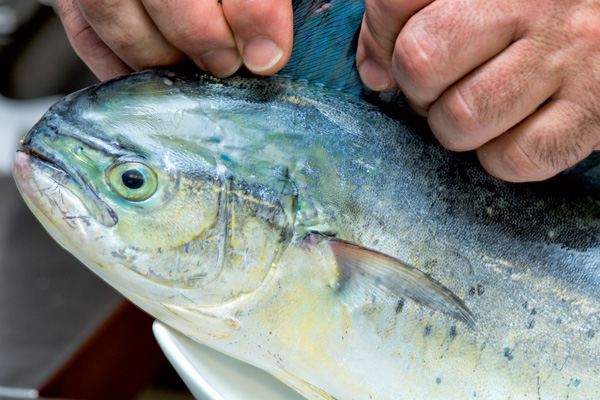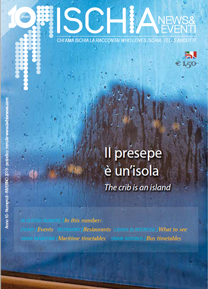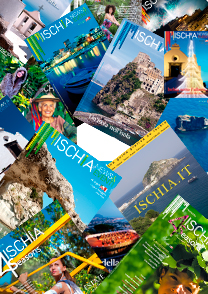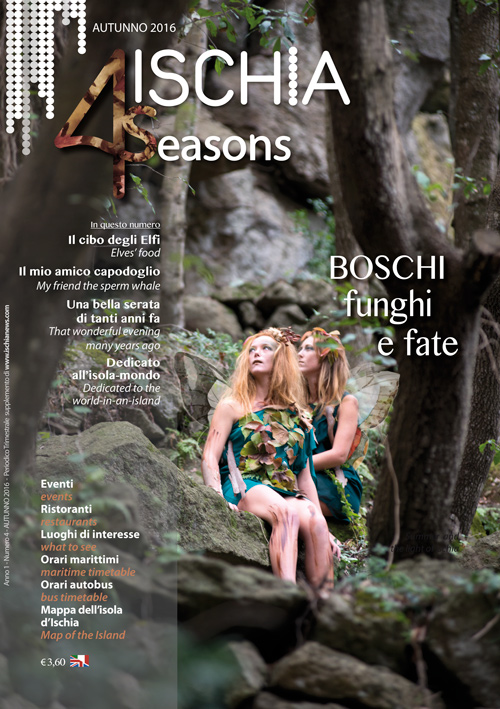Lightning and mahi-mahi

by Ciro Cenatiempo
The flash of the title is an illumination, linked to a special reflection, that of the rainbows of the dolphin that beats under the boat before giving up and letting itself be pulled up: it is a scenographic flash that becomes flashback and pun. As I like it. The dolphin fish has an iridescent, photomutable livery; an archaic face, very ancient and fascinates me in an unspeakable way: it is still captured with the so-called shadow fishing that uses palm trees and branches, and is one of the most popular and tasty (blue) fish known from the dawn of Mediterranean civilization and not only.
The dolphin fish is a real sinuous queen, and it is part of us, without you having noticed it… also because its fame has been clouded by the presumed economic nobility of other species. So much it is. When I was in Santorini, I couldn't wait to go to the Akrotiri site, where 37 centuries ago there was a Cycladic city at the forefront of sophisticated social organization and its urban, engineering, off-shore fishing achievements. ; and therefore for technique and culture. It was buried by the explosion that gutted half of the island between 1627 and 1600 BC. Pompeii of the Aegean. But here the inhabitants managed to leave in time: there had been many signs, strong warning shocks before the terrible event. It was crazy: the most massive eruption, the mother of all volcanic eruptions ever, triggered a tsunami that reached Crete, triggered the decline - even for a concomitant series of mega earthquakes - of the Minoan civilization that had shaped that of the Cyclades, and changed the path that our history would take. At the Archaeological Museum of Fira (Thira or Thera), where there are the most beautiful finds of that amazing era, I paused in devout admiration in front of the fresco of the "young fisherman" (it was located in room number 5 of the "House West »of Akrotiri) showing its prey: two clusters of mahi mahi, a dozen in total. It is one of the best known images of that fantastic period of conquests, travels, exchanges, crossings on the sea. And it is certainly the first representation of the lampuga, or corifena (of the Corifenidi family, in fact); or capone fish, as it is also known along the Sicilian coastal strips. A name, the Sicilian one, which triggers a parallel - gastronomic - path that I will try to trace for you later. However, it is the universal symbol of happy fishing, in my opinion.
THE «DORADO» OF HEMINGWAY AND AN EXOTIC CLAMOROUS MISUNDERSTANDING
Lampuga pescata a Curacao Fotografando il pescatore cicladico, mi sono soffermato sulla lunga didascalia leggibile al suo fianco, preparata dai curatori del museo. Mi ha deluso. Troppo generica, per la mia vecchia mania tassonomica: c’è scritto che il ragazzo tiene «una corda con pesci della famiglia dei maccarelli in ognuna delle mani». Maccarelli, ovvero sgombri. Così non va, mi sono detto. E ho immediatamente pensato che il destino altalenante delle lampughe fosse legato un po’ al fraintendimento. La memoria è corsa alla letteratura, quella di rango altissimo. E a una di quelle mazzate che avevo preso un bel po’ di tempo fa, quando ho scoperto che la mia mitica Fernanda Pivano, indiscussa sacerdotessa dei capolavori della narrativa americana (grazie a lei li ho divorati, condividendo la goduria con un paio di generazioni di italiani) aveva addirittura sbagliato la traduzione di un libro-cult di Ernest Hemingway: «Il vecchio e il mare». Tutta colpa della lampuga. Pazzesco. In inglese la lampuga è chiamata dolphinfish, e l’assonanza con il delfino procurò una topica abissale. Faccio una digressione. Leggiamo insieme stralci del grande maestro che vinse il premio Pulitzer nel 1953 e il Nobel per la letteratura l’anno dopo, grazie proprio… alle lampughe. Ecco la primigenia traduzione di un passaggio hemingwayano cruciale. « […] Dev’essere molto strano, in aeroplano, pensò. Chissà com’è il mare da quell’altezza? Dovrebbero veder bene il pesce, se non volano troppo alto. Mi piacerebbe volare molto adagio a duecento tese d’altezza e vedere il pesce dall’alto. Nelle barche per le tartarughe stavo sul pennone di parrocchetto e già da quell’altezza vedevo molto. I delfini sembrano più verdi di lassù, e si possono vedere le strisce e le macchie viola, e si può vedere tutto il branco mentre nuota. Chissà perché tutti quei pesci veloci che stanno nell’acqua buia hanno la schiena viola e per lo più strisce o macchie viola? Naturalmente il delfino sembra verde ma non lo è, perché in realtà è color dell’oro. Ma quando viene a mangiare, che è proprio affamato, sui fianchi gli si vedono strisce viola come sui marlin. Che sia la collera, o la velocità maggiore a farle venir fuori? […] Poco prima che scendesse il buio, mentre oltrepassavano una grande isola di sargassi che si gonfiava e muoveva nel mare chiaro come se l’oceano facesse all’amore sotto una coperta gialla, alla lenza piccola abboccò un delfino. Il vecchio lo vide per la prima volta quando balzò nell’aria, proprio come l’oro nell’ultimo sole e prese a curvarsi e sbattere all’impazzata nell’aria. Continuò a balzare spinto dalla paura e il vecchio ritornò a poppa e accoccolandosi e tenendo la lenza grande con la mano e il braccio destro, tirò il delfino con la mano sinistra posando il piede sinistro nudo sulla lenza ogni volta che ne conquistava un pezzo. Quando il pesce giunse a poppa, tuffandosi e rivoltandosi disperato, il vecchio si sporse fuori dalla poppa e sollevò a bordo il pesce d’oro brunito con le sue macchie viola. Le mascelle si contraevano convulse in morsi veloci sull’amo mentre il pesce batteva il fondo della barca col lungo corpo piatto, la coda e la testa, finché fu preso a mazzate sulla testa dorata scintillante e rabbrividì e rimase immobile. […] Domani mangerò il delfino. Lo chiamò dorado […] ». Eh, è fin troppo chiaro l’errore di traduzione, quel delfino non esiste: l’ultima scena – se si fosse trattato davvero di un delfino – sarebbe stata orripilante. E invece è una semplice lampuga, la protagonista. Proprio come quella grassottella che ho beccato, l’ennesima foto rubata, mentre veniva sbarcata da un peschereccio caraibico sul porto di Curacao non lontano dal mercato galleggiante. Così è andata. Ma non finisce qui.
Above, two images of the "Old" Antonio Masarone. Above, Ernest Hemingway His name was Santiago, the old fisherman in the Gulf Stream from Hemingway's novel. In everyday life, however, he was none other than Uncle Antonio 'u Viecchiu, as he was greeted on the little port of Acciaroli starting in the 1950s. Precisely the period during which Hemingway landed there, during his tour in Italy. There he settled in the village immediately: he did nothing but go around barefoot, drink, offer drinks, ask questions and write, write. In that outpost of Cilento, the "invention" of the Mediterranean Diet was happening at the same time thanks to another American who was later acclaimed, the physiologist Ancel Keys. In this trotting of suggestions, therefore, the excellent Ernest met Antonio Masarone - aka Santiago - and became his friend, with the liquid complicity of whiskey. And he was inspired to make his Cuban fisherman immortal. As Emilio La Greca Romano recently wrote: «[…] And so it was that Uncle Antonio 'u Viecchiu established a cordial relationship with the great writer. “He was a man who never did anything; he put himself under the young palm trees on the square in front of the church, looked at the sea towards the Licosa and wrote with the bottle beside him and walked barefoot like all of us, he wanted to know many things from me". This is how Uncle Antonio remembered him. "He - he argued - loved the sea and those who face it to earn their bread to survive". Uncle Antonio, 'u Viecchiu, spent whole days offshore, away from his family like Santiago and was thin and gaunt and had accentuated wrinkles on the nape of his neck. The Old Man had patches of skin cancer on his cheeks, caused by the reflections of the sun on the tropical sea ”. “The patches ran down the sides of the face and the hands had deep scars, but none of them were fresh. They were - continues the text by Emilio La Greca which evokes Hemingway - all ancient as erosions of a desert without fish. Everything about him was old except the eyes which had the same color as the sea and were cheerful and indomitable. Antonio Masarone remained like this until he died; remained exactly as the writer describes Santiago [...] And of this character, Uncle Antonio felt he had the mind and heart, in it, the old fisherman from Acciarolo easily impersonated himself because he was also his ". Now could you ever imagine that old uncle Antonio Masarone has anything to do with Ischia? And yet it is so. I don't know when he was able to visit the green island - the episode of when he set foot in front of the Redentore quay is a bit legendary like his life - but it is only too true that his niece Anna lives in Forio. daughter of Antonio's daughter ... I recently discovered this little piece of history, with the precise awareness that our world is not only ... round, and difficult - as Graziano Petrucci remembers slyly - and small, but too magnificently full of surprises to treat him badly.









